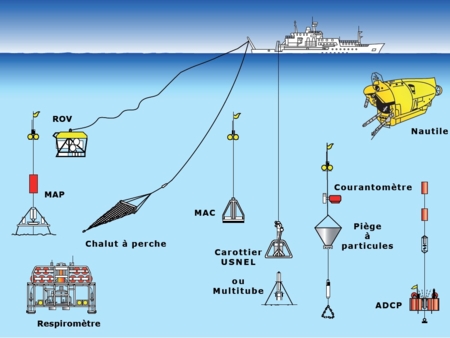Soutenance de Thèse de Blandine TROUCHE
Exploring the deep ocean seafloor Bacteria and Archaea, from microbial community structure to comparative genomics
Venez nombreux à la soutenance de thèse de Blandine Trouche. Rendez-vous dans l'Amphi A de l'IUEM Mercredi 7 Juillet à 14 h
Résumé
Marine sediments cover around 65% of the Earth’s surface and microorganisms inhabiting these environments play an essential role in marine biogeochemical cycles. Located at the interface between pelagic and subsurface communities, Bacteria and Archaea of the benthic boundary layer are responsible for the early diagenesis of sinking organic matter and determine the partitioning between buried organic matter and nutrients released in the water column. Likely encompassing a broad range of unique biodiversity and functional adaptations, they are still sparsely described. As part of the “Pourquoi pas les Abysses ?” project, this thesis endeavored to shed light on the structure and functional diversity of deep-sea benthic microbial communities.
To this end, we implemented large-scale standardized methods of sampling, DNA extraction, and bioinformatic processing to recover environmental DNA data. Firstly, using 16S rRNA amplicon sequencing, we observed a segregation of Mediterranean and Atlantic benthic communities based on water depth, delineating a threshold between 800 and 1200 meters. In addition, we found that biogeographic patterns depended on the scale considered, with the historic influence of dispersal limitation and drift superseding environmental selection at larger scales (i.e. > 2000 km). The influence of ecological drift was also proposed to explain the increased divergence of communities with increasing sediment depth.
Evidence of the structuring influence of bathyal gradients and sediment horizon was further confirmed using co-occurrence networks built from archaeal communities of the surface sediments of two South Pacific hadal trenches. The dominant archaeal classes, Nitrosophaeria and Nanoarchaeia, were partitioned following these environmental niches, with a variety of putative partners for the symbiotic Nanoarchaeota lineage. Using metagenomic sequencing and analysis on the same hadal samples, 90 archaeal MAGs were reconstructed from the corresponding hadal metagenomes, including 53 affiliated with Nitrososphaeria. We analyzed the genome repertoire of these archaea and identified functional specificities corresponding to ecological niches delineated in the first part of our study. Overall, these results lay the foundations for continued investigation of the functional diversity and adaptation of deep-sea sediment microbial communities.







